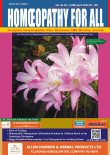Homeopathic Management of Dentition Problems in Children Based on the Underlying Mechanism
Keywords:
Homeopathic, Underlying, MechanismAbstract
Teething was formerly referred to as " Dentitio difficilis,"1 which means in Latin abnormal or challenging tooth development. Dentition is a normal physiological process that often happens without complications. The process involves the tooth transitioning from its intraosseous location within the mandible to emerging into the oral cavity.2 In children, the commencement of this process takes place from six months and may last upto 3 years. Teething is an unavoidable milestone in the development of an infant: it signals the beginning of further developmental processes. Approximately 385,000 babies are born each day worldwide, according to the United Nations data, who experience teething in their first years of life. Globally, teething is a universal occurrence with the majority of infants experiencing some form of discomfort.
Downloads
References
Meer Z, Meer A. Teething trouble and its management in children. Int J Dent Clin. 2011 Jun 30;3(2):75-.
Noor-Mohammed R, Basha S.
Teething disturbances; prevalence of objectivemanifestations in children underage 4 months to 36 months. MedOral Patol Oral Cir Bucal. 2012 May 1;17 (3):e491-
http://www.medicinaoral. com/medoralfree01/v17i3/ medoralv17i3p491.pdf
Wake, M., Hesketh, K., & Lucas, J. (2000). Teething and tooth eruption in infants: A cohort study. Pediatrics, 106(6), 1374-
https://doi.org/10.1542/ peds.106.6.1374
Aliabad GM, Teimouri A, Noori N, Khajeh A. Beliefs of physicians and nurses toward infant teething: A cross sectional survey. Jentashapir Journal of Health Research. 2016 Aug 1;7(4).
Ernst, E. (2002). Homeopathy: Past, present, and future. British Journal of Clinical Pharmacology, 54(6), 577-582. https://doi.org/10.1046/j.1365-
2002.01699.x
Un Lam C, Hsu CY, Yee R, Koh D, Lee YS, Chong MF, Cai M, Kwek K, Saw SM, Gluckman P, Chong YS. Early-life factors affect risk of pain and fever in infants during teething periods. Clinical oral investigations. 2016 Nov;20:1861-70.
Ashley MP. It’s only teething... a report of the myths and modern approaches to teething. British Dental Journal. 2001 Jul;191(1):4-8.
McIntyre, G. T., & McIntyre, G. M. (2002). Teething troubles? British Dental Journal, 192(5), 251-255. https://doi.org/10.1038/ sj.bdj.4801348
Bhatti, R. C., Nirmala, C., Kaur, A., Singh, S., Kumar, P., Kaur, R., & Singh, A. N. (2017). Harnessing of local plant species by indigenous people of Hamirpur district for ethno
veterinary purposes. Annals of plant sciences, 6(12), 1898-1925. 10. Mittal, N. P., & Goyal, M. (2014). Dexmedetomidine: a potential agent for use in procedural dental sedation. Indian Journal of Dentistry, 5(1), 21-27.
Markman, L. (2009). Teething: facts and fiction. Pediatric Reviews, 30(8), e59-e64. https:// doi.org/10.1542/pir.30-8-e59
LANSKY, A. Safe, effective medicine.
J. H. Clarke, Dictionary of Practical Materia Medica, Reprint Edition 1992, B. Jain Publishers, New Delhi.
Kavare, S. F. (2020). Effectiveness of Homoeopathic Constitutional
Medicine and Calcarea Phosphoricum in the Management of Calcium Deficiency in Women Attaining Menopause-A Randomised Control Trial (Doctoral dissertation, Rajiv Gandhi University of Health Sciences (India)).
Eldridge, J. (2000). The relative effectiveness of a homoeopathic complex (Calcarea carbonica 15CH, Calcarea phosphorica 15CH, Chamomilla 30CH, Kreosotum 30Ch and Pulsatilla 30CH) compared with a herbal teething gel (Plantago tincture, Verbascum tincture and Kava Kava tincture) in terms of clinical manifestations of problematic teething in infants (Doctoral dissertation).
Page, L. (2004). Healthy Healing: A Guide to Self Healing for Everyone. Healthy Healing, Inc..
Ullman, R., & Reichenberg Ullman, J. (2005). Homeopathic treatment of acute dental conditions. Townsend Letter for Doctors and Patients, (263), 86- 90.
Schüssler, W. H. (1885). An Abbreviated Therapy: The Biochemical Treatment of Disease. FE Boericke.
Lewis Shapter, B. A. (1882). The Therapeutic Uses of the Herba Pulsatillae.” Anemone Pratensis” and” Anemone Pulsatilla”(RANUN
CULACEAE). The Practitioner, 29, 32.




